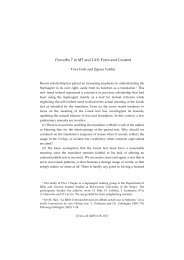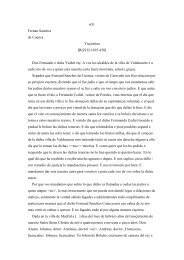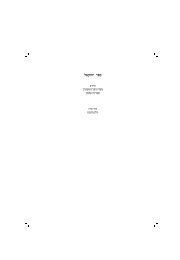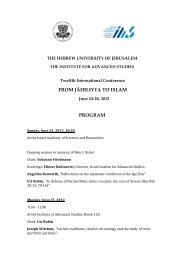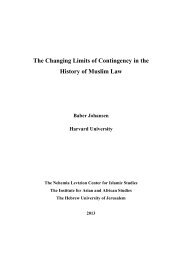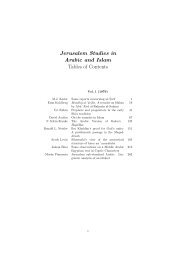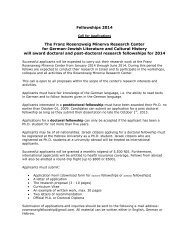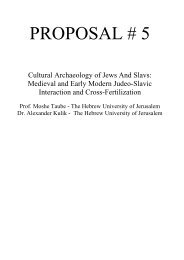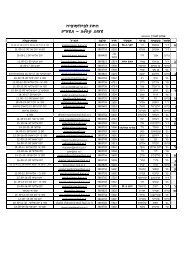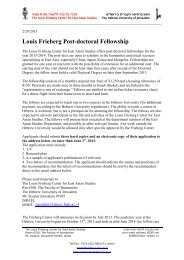THE BOOK OF EZEKIEL Moshe H. Goshen-Gottstein Shemaryahu ...
THE BOOK OF EZEKIEL Moshe H. Goshen-Gottstein Shemaryahu ...
THE BOOK OF EZEKIEL Moshe H. Goshen-Gottstein Shemaryahu ...
You also want an ePaper? Increase the reach of your titles
YUMPU automatically turns print PDFs into web optimized ePapers that Google loves.
Introduction<br />
beyond the end of a verse have the verse number in parentheses in the lemma (for example,<br />
1:25). A notation pertaining to an entire verse, mainly of the ‘pers’ type, is given without a<br />
lemma. Quotations from the beginning of a verse in a version and without a corresponding<br />
Hebrew text, are indicated by: init] (for example, Apparatus III 4:5; 21:19); and additions<br />
at the end of a verse not found in the MT are indicated by: fin] (for example, Apparatus I<br />
24:14; 33:17). Compound verse numbers, for example 7–9, indicate variants concerning<br />
stretches of text beyond one verse that start at the beginning of a verse; otherwise, such<br />
stretches are indicated by the verse number in parentheses at the end of the Hebrew lemma<br />
(for example 13:17).<br />
42. Quotations are vocalized only to highlight a divergence in vocalization. The vocalization<br />
is usually not complete, but indicates the divergent vocalization. Ketib (k) and qere (q)<br />
readings are noted only when retroversion yields a difference pertaining to the k/q reading<br />
itself. In such cases both forms are quoted as the lemma, separated by an oblique stroke (for<br />
example, 3:15). Marginal readings in the Aleppo Codex designated by yetir (xizi) are considered<br />
equivalent to qere readings, and are marked in the lemma with y (for example, 9:5).<br />
43. Recurring words in a verse are identified by a small superscript Arabic numeral, for<br />
example,<br />
2<br />
z`. If the same consonantal form occurs more than once in a verse, they are<br />
differentiated by vocalization. Generally, not more than two words are quoted as a lemma.<br />
However, in cases of particular phrases or idiomatic expressions, context was provided in<br />
parentheses (for example, 2:8). In a lemma of three or more words, the first and final vocables<br />
are spelled out, separated by an en-dash (–). In a quotation of non-consecutive words,<br />
the break is indicated by an ellipsis (…), with the variant concerning only the words in the<br />
lemma (for example, 1:27). These conventions are used for all apparatuses.<br />
44. Variant readings are recorded after the symbol of the respective version. If the reading<br />
is documented by only some witnesses of a version, the symbol of the source is enclosed in<br />
parenthesis, for example (T). The part of the text reflecting variants in the transmission of<br />
] may also be enclosed in parentheses (for example, 10:2). Aramaic quotations are printed<br />
in ‘Miriam’ typeface (xninl), and Latin ones in italics.<br />
45. Readings from different versions referring to the same lemma are quoted in the pertinent<br />
scripts in a fixed order: ] * T [, and if testifying to (approximately) the same<br />
reading, are separated by semicolons. 32 If, in the editors’ opinion, they testify to different<br />
readings, they are separated by a vertical stroke |. 33<br />
46. When two versions testify to the same reading, often only one (mainly ]) is quoted<br />
in full, and the other is referred to by an equal sign (=). Almost identical testimony is indi-<br />
32 The order reflects the traditional history of the translations in general terms, but not their literary<br />
crystallizations. A symbol for one of ‘the Three’ (see below) before the symbol ]h indicates the<br />
possible influence of one on the other (e.g. at 27:24 millknk; 28:14 gynn). At times one (or more) of<br />
‘the Three’ is noted after ] (e.g. at 21:35 ayd; 22:4 `eaze). Readings from Jerome’s commentary<br />
(Hier) are occasionally adduced in the notes (e.g. 22:16, n. 2). ~|9 are quoted in the apparatus in<br />
Syriac if the evidence is from the Syrohexapla (e.g., 22:17), and in Latin if it stems from Jerome (e.g.,<br />
22:16). Suggested retroversions are given in the notes.<br />
33 Similarly, in the other apparatuses the vertical stroke is used to distinguish between variants of a<br />
slightly different character.<br />
xx



